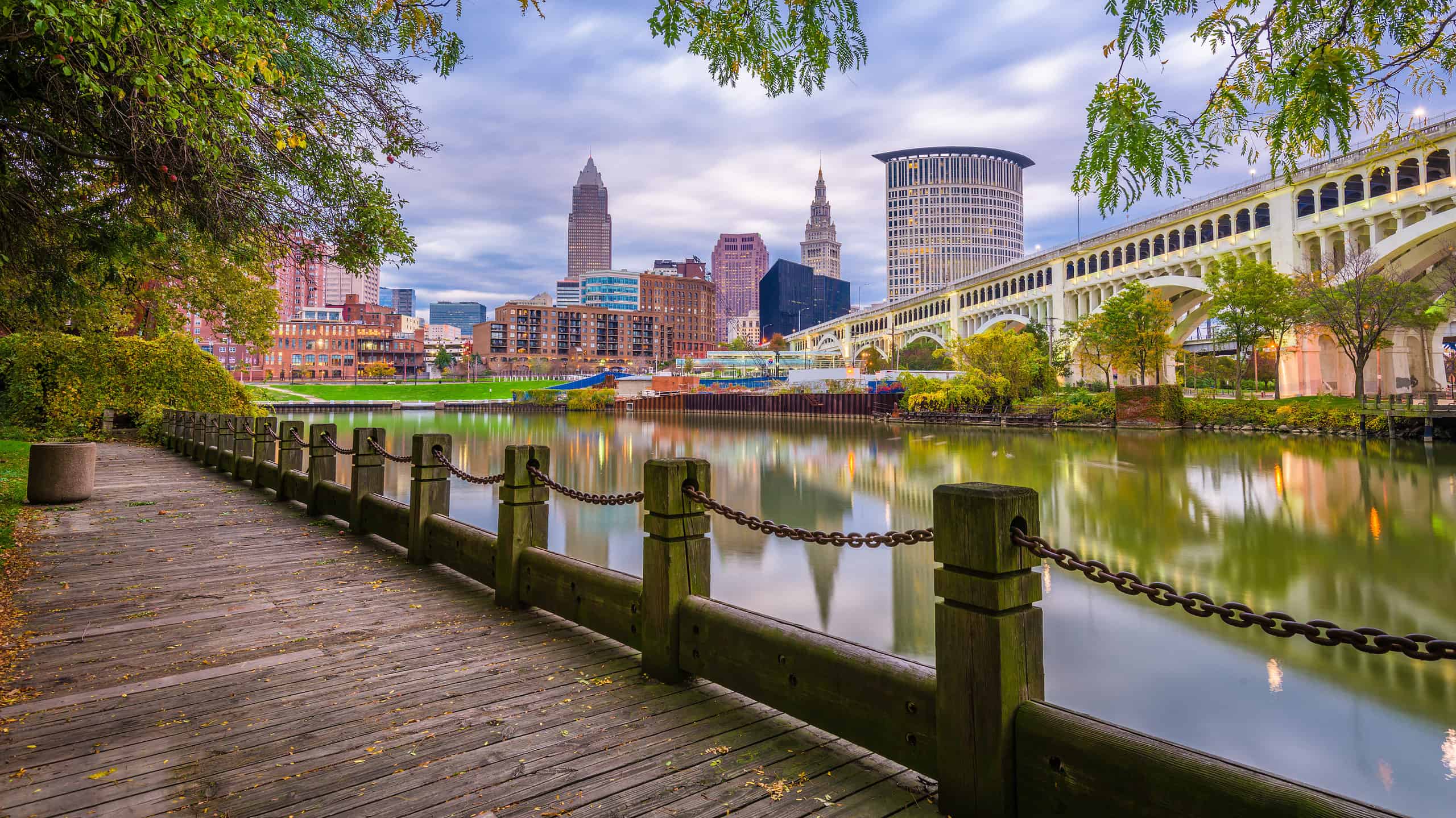The Cuyahoga River, pronounced “kai·uh·how·guh,” is one of the youngest rivers in the United States. How deep is the Cuyahoga River? It is 70.88 feet at its deepest point but averages a low 3 to 6 feet depth overall. The deepest part of the river is right before it empties into Lake Erie in Cleveland where the mouth forms part of Cleveland’s harbor.
So, why is the Cuyahoga River important to the Midwest? The river is a vital part of Ohio’s infrastructure because it gives access to transportation routes. This access made Cleveland a major manufacturing and shipping center.
The river was also a birthplace of oil, rubber, and modern steel industries, as well as a power source. It is a major part of the Port of Cleveland and a major route on the Great Lakes system that helps serve international, national, and regional ports. The Cuyahoga River is small but mighty. It brought national attention to river pollution when it caught on fire in 1969.

The Detroit Superior Bridge, or the Veterans Memorial Bridge, crosses the Cuyahoga River in Cleveland.
©Belikova Oksana/Shutterstock.com
The Founding of Cleveland
Moses Cleveland, the founder of Cleveland, also formed the township of Euclid at the mouth of the Cuyahoga River in 1796. The Cuyahoga River had a great influence on Native Americans. They named it “Cuyahoga,” meaning “crooked river.” Multiple tribes, such as the Ottawa and Ojibwa, inhabited the area, using the river for transportation and food. The river made it easy for Native Americans to live in the area, thanks to the large game that inhabited its shores and its abundant supply of fish and plants.
However, European settlers pushed out the natives starting in the 1600s, beginning the river’s demise. The European settlers were fur traders, and this trade started the “end of innocence” for the river, as it became popular for industry-driven work. Then, after the War of 1812, western settlers displaced the Native Americans. The Cuyahoga River became a prime spot or a “super highway” during the early 1800s. Its canals were part of the industrialization, linking Cuyahoga with Lake Erie. Even Benjamin Franklin and George Washington knew the importance of the river.
In 1827, the Cleveland to Akron section of the canal opened. The Cuyahoga River and its canals became the center of commercial transportation. Boats carried agricultural products and coal for the smokestack industry along with novelty items such as coffee and glass through the waterways. Irish immigrants and German stonemasons dug the canals at a rate of 30 cents a day. The working conditions meant almost certain death due to the high prevalence of malaria. And after all that suffering, it soon closed due to the railroad.
The Cuyahoga continued to drive industry, which became the prime source of the river’s pollution. When John D. Rockefeller brought the oil business to Cleveland, the economy sky-rocketed, but the river’s health fell. No dumping laws existed at the time, so everything was put into the river. This included refined oil, gasoline, oil, paint, and metals. All the pollutants were callously dumped into the once pristine waters. Nicknamed, a “rainbow of many different colors” due to the pollution, the waters were unsafe. And before the turn of the century, it was falsely thought that a dirty river was “a sign of prosperity.”

Cleveland, Ohio’s skyline lights up the Cuyahoga River at night.
©Matt Dacek/Shutterstock.com
The Burning River
Though industry prospered, the Cuyahoga River hit rock bottom in 1969. The river is now one of the most severely polluted rivers in the United States. It became national news on June 22, 1969, when an oil slick on top of the river caught fire. It was an event so monumental that it was memorialized in Rock n’ Roll. Randy Newman wrote “Burn On,” and R.E.M. references the burning waters in their song “Cuyahoga.”
The fire damaged two railroad bridges before it was put out, but the damage was done. The river was dead. A dead river means there is no oxygen in the water, which makes it impossible for plants or animals to live in its waters. In fact, only two months after that famous fire, Time magazine famously declared that the Cuyahoga River “oozes rather than flows.”
The river actually caught fire a dozen times before this incident. However, this fire was the one that captured the world’s attention. In fact, his last fire only lasted 24 minutes. It was so short, there aren’t actually any photos of the water burning. The photos that ran alongside the story were actually from a fire in 1952, almost a decade earlier.

The Cuyahoga River was created from the last glaciers ever seen in the United States
©Zack Frank/Shutterstock.com
The Cuyahoga River Recovers
The blazing river became a symbol of an environmental movement in the 1970s. National Geographic put the Cuyahoga River on its cover in their December 1970 edition, and a month later Congress established the Environmental Protection Agency. The nation made the Cuyahoga River the face of the reality of industrial pollution, and by the late 1970s, antipollution measures dramatically improved the river’s condition. The 1972 Clean Water Act established the basic structure for regulating what is allowed to be discharged into the waters of the United States. It also established quality standards for surface waters.
The Cuyahoga River was once a national joke, but it is now an inspiration. America’s fury about water catching fire helped transform the dump site into the “River of the Year” in 2019. And in the same year, the river experienced another major milestone. Federal environmental regulators declared the river’s fish safe to eat. The Cuyahoga River now supports aquatic life, and beaches are open to the public for picnicking, swimming, and recreation. The river is not perfect, but it reveals how humans can help heal the nature they destroyed.
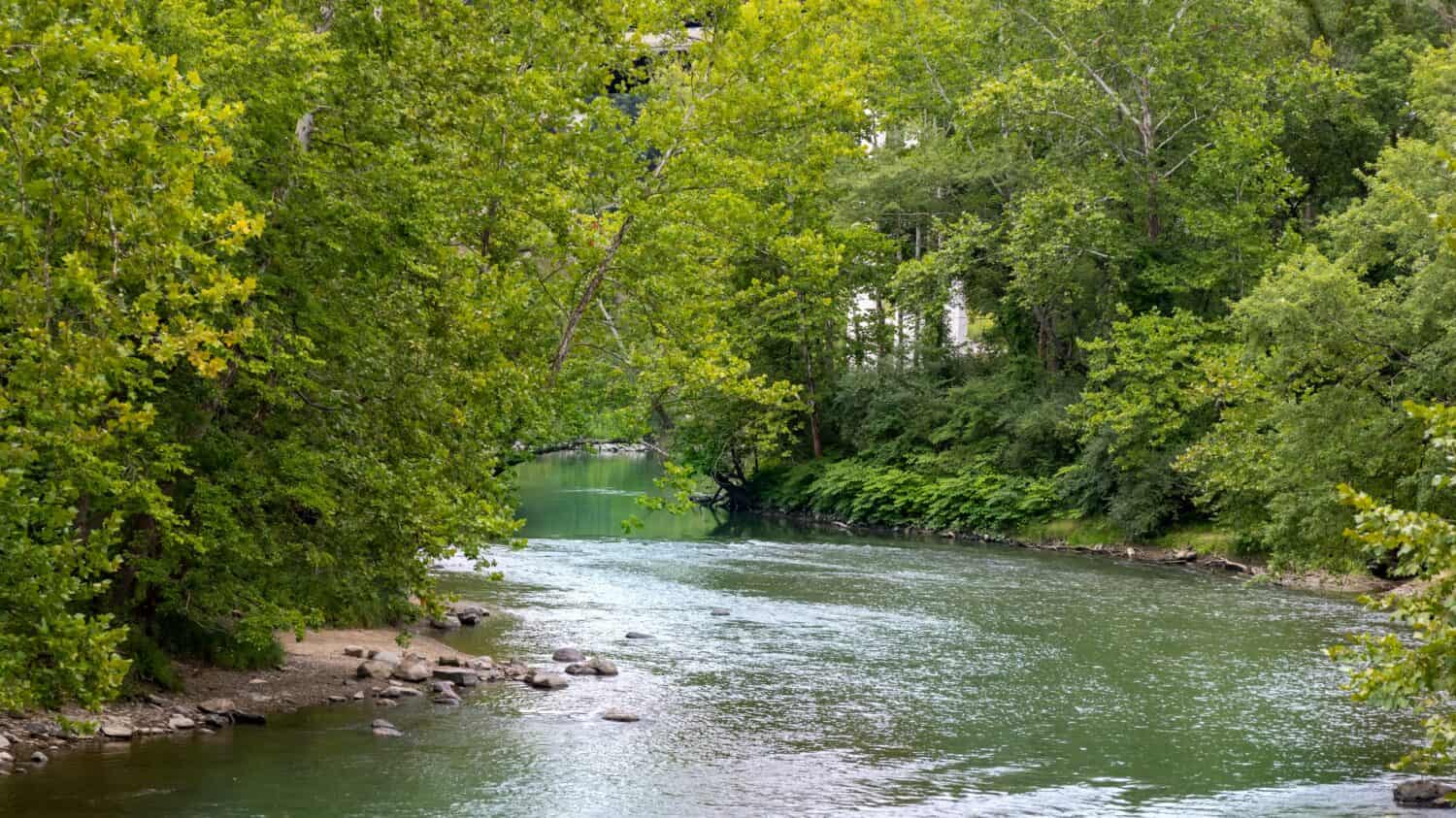
Lush green trees grow alongside the Cuyahoga River in Cuyahoga Valley National Park.
©SNEHIT PHOTO/Shutterstock.com
Ecology of the Cuyahoga River
Once known as “the river that burned,” the Cuyahoga River went through a resurgence, and nature is thriving. Committed local officials and environmental activists helped the river’s ecological comeback. Visitors are seeing river otters, aquatic insects, great blue herons, and other species make their homes in the river once again. Also, bald eagles, who were absent from the Cuyahoga area for over 70 years, are nesting in the area as well. There are over 40 species of fish in the river, such as steelhead trout and northern pike. Both these fish can survive in low-pollution water sources. The Cuyahoga River may never be out of the woods when it comes to restoring its waters completely, so, continuous cleanup and dedication are important to protect and enhance the river’s waters and shores.
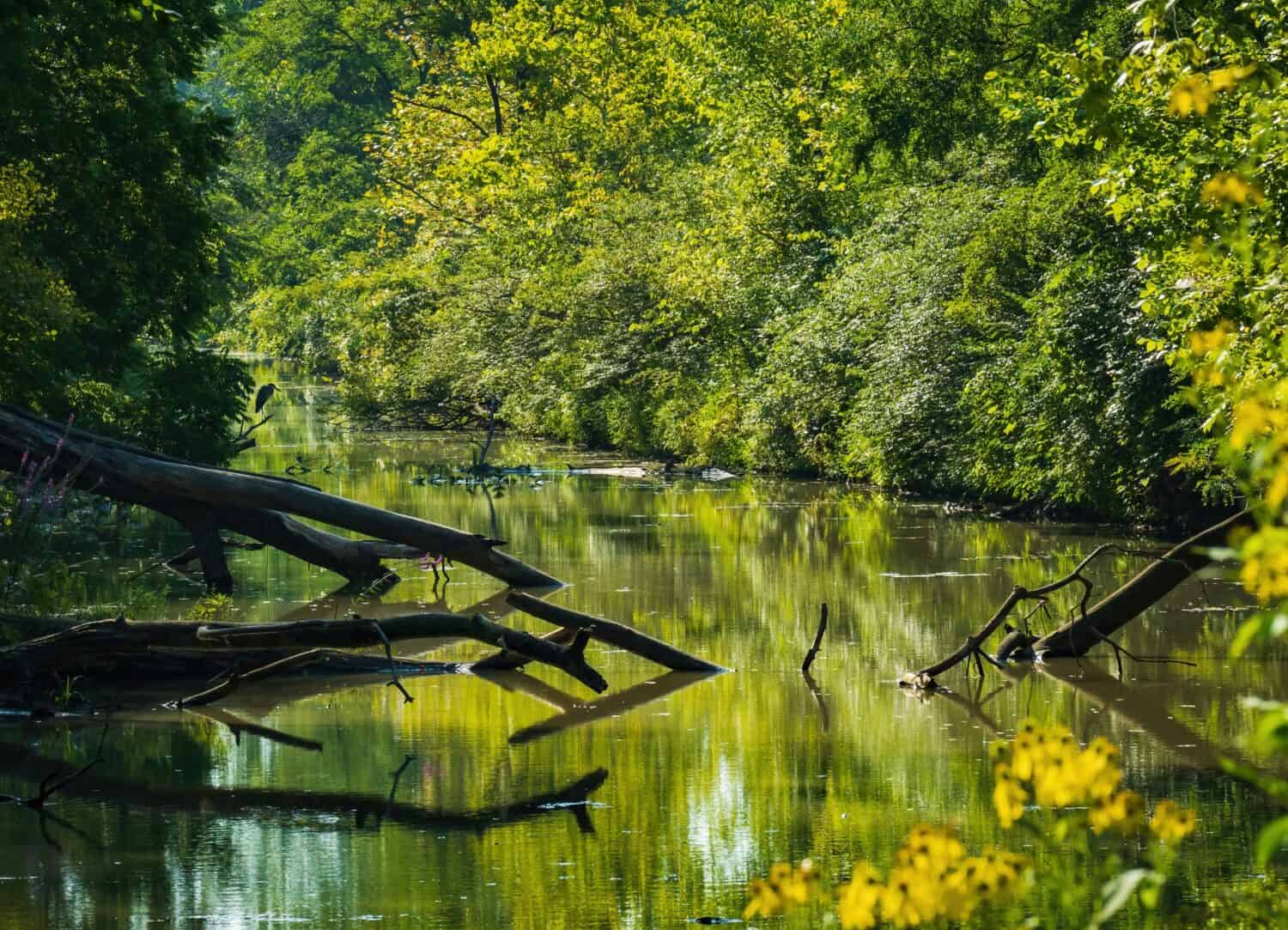
The health of the Cuyahoga River is still a work in progress.
©Marked Imagery/Shutterstock.com
What To Do on the Cuyahoga River
Cuyahoga Valley National Park preserves the winding Cuyahoga River and its surrounding deep forests, wetlands, and hiking and biking trails. Visitors can walk under covered bridges, ride a train through the national park, and photograph roaring waterfalls. People can also learn about the Ohio and Erie Canals at the Canal Exploration Center. There is even a fully operational canal lock on the property!
Various stretches of the river welcome kayaks, canoes, standup paddleboards, sculls, and dragon boats. Visitors can fish in the newly revitalized waters as well. Visitors can even golf alongside the river. Four privately managed public golf courses sit in the national park. There are food stops in the park as well. A fun activity is biking on the Towpath Trail and stopping for a snack along the way. Cuyahoga National Park may be between the urban areas of Cleveland and Akron, but it transports visitors to a beautiful, wooded paradise alongside a refreshed river.
Downtown Cleveland also sits on the Cuyahoga River. The city continues to use the beauty of the river and even redeveloped The Flats of downtown to sit on its banks. With a vibrant nightlife, edgy bars and clubs, live music, comedy shows, and open markets, The Flats brings life back to the river’s banks. The restaurants and bars contain beer gardens and patios to enjoy Midwest summers. There is also a walkway on the west bank of the waterfront, as well as water taxis that transport people from one side of the river to the other.
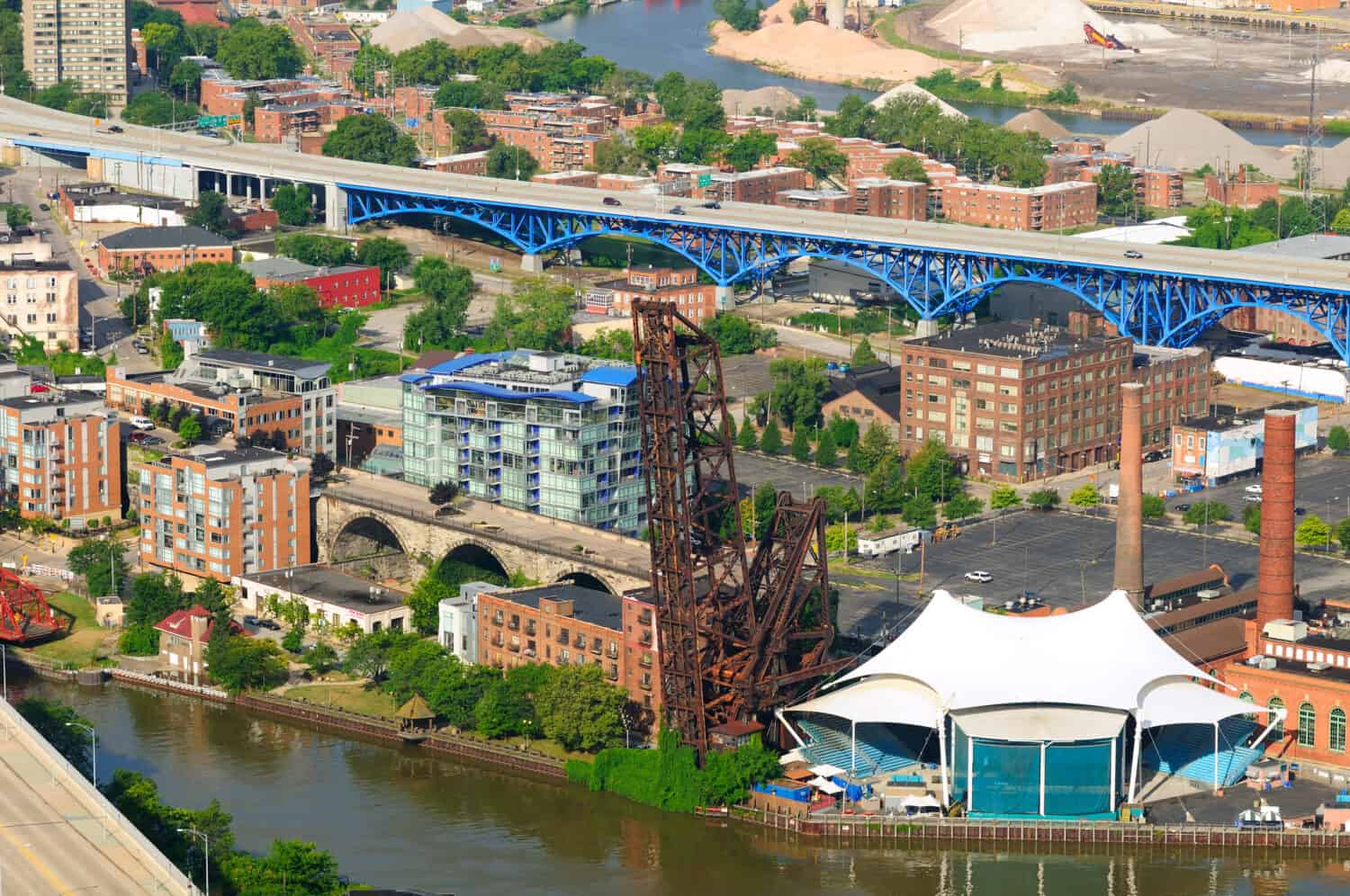
The Flats in Cleveland, Ohio, uses restaurants and bars to show the beauty of the Cuyahoga River.
©Kenneth Sponsler/Shutterstock.com
Where is the Cuyahoga River Located on a Map?
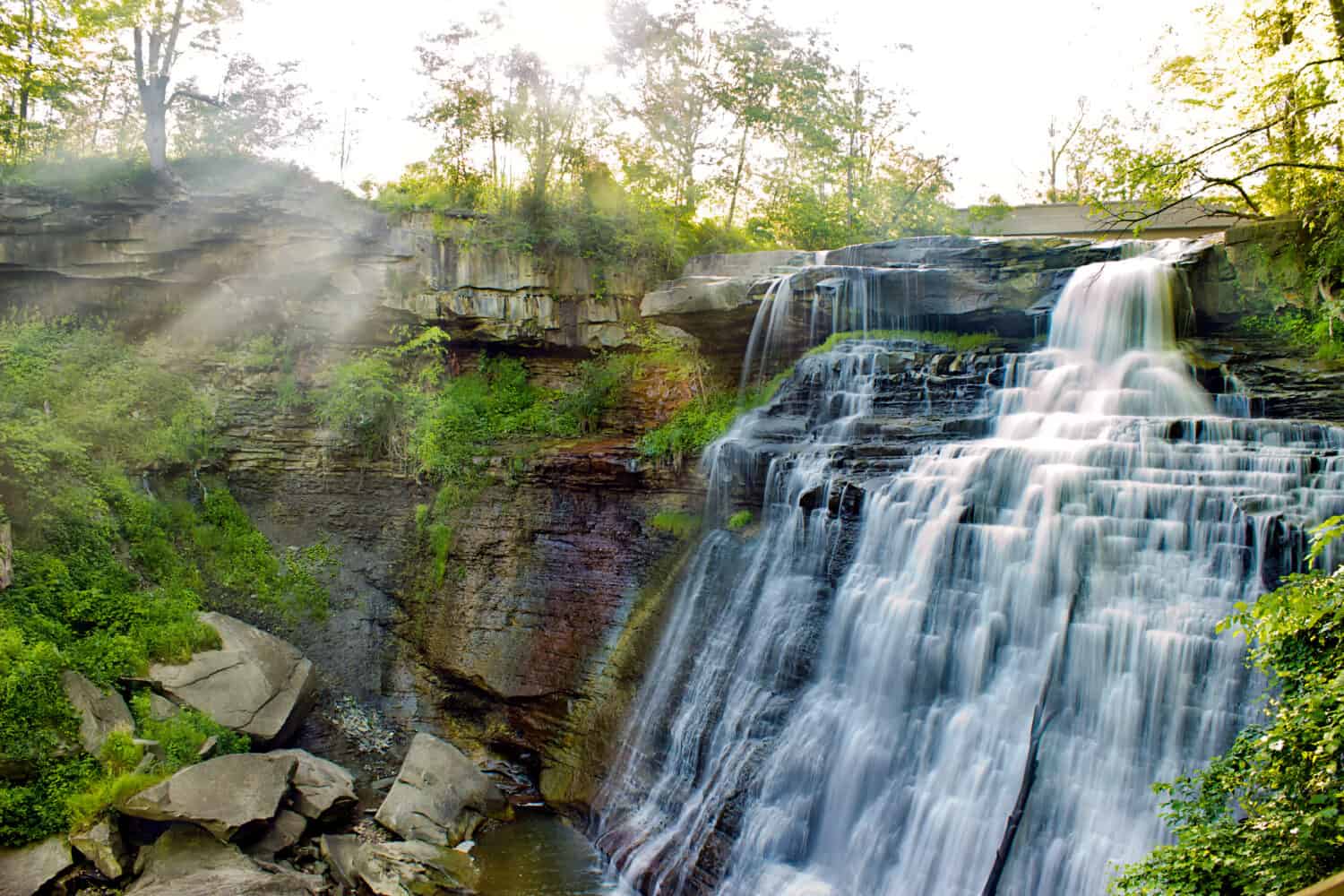
Brandywine Falls is a great photo opportunity for visitors at Cuyahoga Valley National Park.
©Ashley Marie Best/Shutterstock.com
The Cuyahoga River stretches 100 miles across Northeast Ohio. The river flows south in a U-shape, starting near Burton and bending in Akron. It then heads north through Cuyahoga Valley National Park toward Cleveland. The river waters then spill into Lake Erie.
Thank you for reading! Have some feedback for us? Contact the AZ Animals editorial team.

